As a medical professional, I have encountered countless patients struggling with oily skin. This common dermatological concern can be a source of discomfort and frustration, often leading to self-esteem issues. Understanding the causes, diagnosis, and treatment options for oily skin can help individuals manage this condition more effectively.
Oily skin is characterized by an excess production of sebum, the skin’s natural oil. This overproduction can lead to a shiny or greasy appearance, enlarged pores, and an increased propensity for acne breakouts. The root causes of oily skin can be attributed to various factors including genetics, hormonal fluctuations, diet, stress, and environmental conditions.
Diagnosing oily skin is typically straightforward. As a doctor, I rely on both physical examination and patient history. During the physical examination, I look for the telltale signs of oily skin: a shiny or greasy appearance, enlarged pores, and the presence of blackheads or pimples. Patient history is equally important as it provides insights into potential triggers such as dietary habits, lifestyle factors, and hormonal changes.
Once a diagnosis of oily skin is confirmed, the next step is to devise a suitable treatment plan. It’s important to note that while oily skin cannot be completely cured, it can be effectively managed with the right skincare regimen and lifestyle modifications.
The cornerstone of oily skin management is a consistent skincare routine. This should include cleansing twice daily with a gentle, oil-free cleanser to remove excess sebum and prevent pore-clogging. It’s a common misconception that harsh cleansers or excessive washing will solve oily skin; in reality, these practices can strip the skin of its natural oils, prompting it to produce even more sebum in response.
In addition to cleansing, I often recommend using a toner to remove any residual oil and tighten the pores. However, it’s crucial to choose an alcohol-free toner as alcohol can over-dry the skin, leading to increased oil production.
Moisturizing is another essential step that is often overlooked by those with oily skin. While it may seem counterintuitive, using an oil-free, non-comedogenic moisturizer can help regulate sebum production and maintain the skin’s natural moisture balance.
Beyond skincare, certain lifestyle modifications can also help manage oily skin. A balanced diet rich in fruits, vegetables, and lean proteins can promote overall skin health. Limiting the intake of oily, spicy foods and refined sugars can also help control sebum production. Regular exercise is beneficial as it helps regulate hormones and reduce stress, both of which can contribute to oily skin.
In severe cases, or when over-the-counter products aren’t effective, I may prescribe topical medications such as retinoids or oral medications like oral contraceptives or anti-androgens to help regulate sebum production.
Lastly, it’s important to remember that everyone’s skin is unique. What works for one person may not work for another. Therefore, it’s essential to consult with a healthcare professional or dermatologist to devise a personalized treatment plan.
Unmasking oily skin requires understanding its causes, recognizing its symptoms, and implementing a comprehensive treatment plan. With the right approach, those struggling with oily skin can effectively manage their condition and achieve healthier, more balanced skin.



